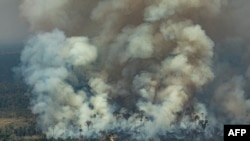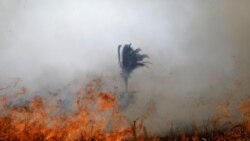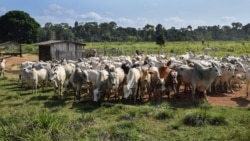On April 3, Eduardo Bolsonaro, one of the Brazilian President Jair Bolsonaro’s sons and a lawmaker, tweeted that “Brazilian agribusiness does not deforest the Amazon, it generates clean energy and helps to conserve the forest that occupies 61% of Brazil's territory.”
An accompanying video reported that 46% of Brazil's “energy matrix” is from renewable sources – hydroelectricity, solar, wind and bioenergy – three times higher than the rest of the world. The video also claimed that "70% of all renewable energy comes from rural areas."
Although the video’s 46 percent figure is accurate, Eduardo Bolsonaro's claim that agribusiness doesn't cause deforestation in the Amazon is false.
Moreover, the assertion that the Amazon occupies 61% of Brazil’s area is slightly exaggerated. The Brazilian Institute of Geography and Statistics (IBGE) says the Amazon’s area is just above 5 million square kilometers (1.9 million square miles), or 59% of the country's territory.
Deforestation in the Amazon is directly linked to the demand for commodities and economic growth in the region. Before the 1970s, the rainforest occupied 4 million square kilometers; it is now 20% smaller.
In the early 2000s, Brazil launched a plan to fight deforestation with increased oversight and monthly satellite monitoring. Between 2005 and 2012, the country was able to grow its agribusiness sector without increasing Amazon deforestation. But deforestation began to increase in 2013 under a new, less rigorous forestry code.
Between August 2018 and July 2019, the size of the deforested area in the Amazon exceeded 10,000 square kilometers – the highest pace of deforestation in 11 years. The following year (August 2019 to July 2020), deforestation increased to more than 11,000 square kilometers.
Part of Brazil’s deforestation is the result of legal development. The forestry code requires the preservation of 80% of the original forest on properties within the Amazon (meaning only 20% of a farmer's property can be deforested). But most of the deforestation is a result of illegal development. In 2019, 99% of deforestation was not authorized or happened in areas that were on indigenous lands or otherwise protected.
Multiple reports and studies have shown how agriculture, especially cattle and soybean production, is one of the biggest drivers of deforestation in Brazil.
From 1985 to 2018, Brazil lost 890,000 square kilometers of natural forests (an area greater than Spain and Germany combined). During the same period, the area designated for agriculture and livestock increased by 860,000 square kilometers, the Brazilian newspaper Globo reported, based on satellite and geoprocessing data by MapBiomas, an initiative of Brazil's Climate Observatory.
MapBiomas also partnered with the Amazonian Georeferenced Socio-Environmental Information Network (RAISG) – a consortium of civil society organizations from countries that have Amazon rainforest (including Columbia, Ecuador, Venezuela, Peru and Bolivia). A report in 2020 which showed that agribusiness was responsible for 84% of deforestation in the Amazon concluded: "Consequently, the pace of transformation of these areas follows a pattern similar to that of deforestation."
A 2019 study by Chain Reaction Research (CRR), a consortium of nongovernmental organizations, also singled out agriculture as a culprit in deforestation. It found that "the large number of fires in Brazil was not only related to clearing new land for agricultural purposes. Farmers also set fires to clear and maintain areas for new pastures for cattle grazing and remove any excess vegetation."
In July 2020, Science Magazine published a peer-reviewed study that addressed the link between illegal deforestation and European Union imports of Brazil's beef and soy. The authors found that "2% of properties are responsible for 62% of all potentially illegal deforestation and that roughly 20% of soy exports and at least 17% of beef exports from both biomes to the EU may be contaminated with illegal deforestation."
And despite a Soy Moratorium signed in 2006, under which companies agreed to not buy soy grown in deforested areas in the rainforest, the authors found that even farmers in compliance "are clearing the forest for pasture or other crops within their holdings, and hence are still profiting from deforestation."
The supply chain of the beef sector allows deforestation to happen without the direct involvement of large agro-industrial conglomerates. The conservation publication Mongabay pointed to "cattle born in deforested areas [by grileiros, or land grabbers] blacklisted by IBAMA, Brazil’s federal environmental enforcement agency, which are then sold to small and medium-sized farms. After fattening, they are legally purchased by large meatpackers."
Trase (Transparency for Sustainable Economies), a supply chain transparency initiative, analyzed beef, offal, and live cattle exports during 2015-2017, and mapped "the supply chains of Brazilian beef and live cattle exports from the municipalities where cattle are raised through to the importing countries" along with deforestation alerts in those regions.
Trase estimated that 2,100 square kilometers of deforestation between those years – an area larger than London – were linked to exports. Of those exports, 38% went to Hong Kong and mainland China.
Investigations by Brazil’s federal public ministry (MPF) have shown links between the beef sector and land grabbing, fires and deforestation.
Experts have blamed President Bolsonaro’s pro-agribusiness rhetoric and his cabinet's actions to weaken environmental agencies for the increase in deforestation. During a campaign visit to the state of Rondonia in 2018, Bolsonaro said: "[I]t's absurd what is done in Brazil using the name of the environment. We have an area larger than the southeastern region [of Brazil] demarcated as an indigenous land, and this has inhibited those who want to invest in agribusiness and even family farming. Let's find an inflection point in that.”








